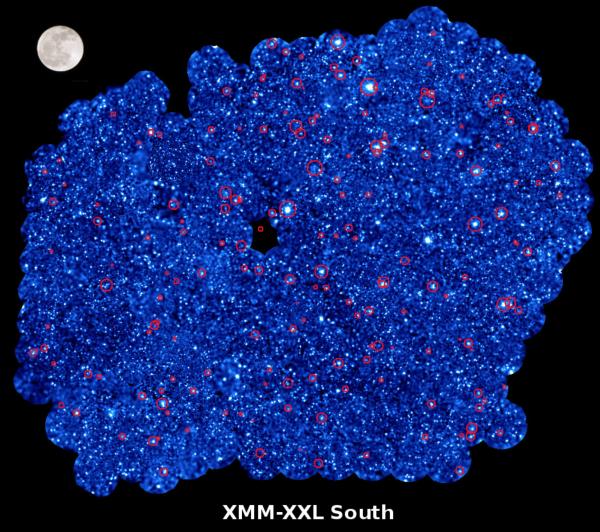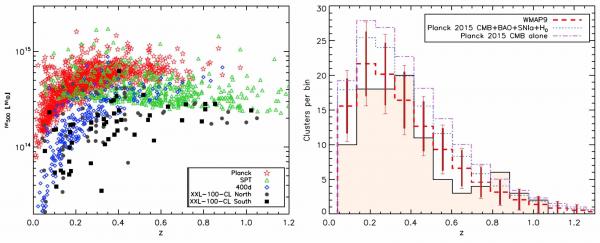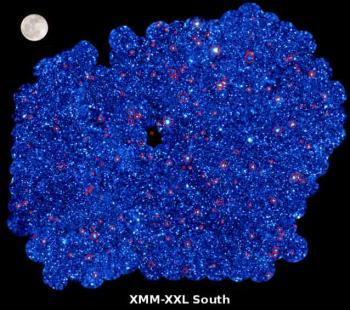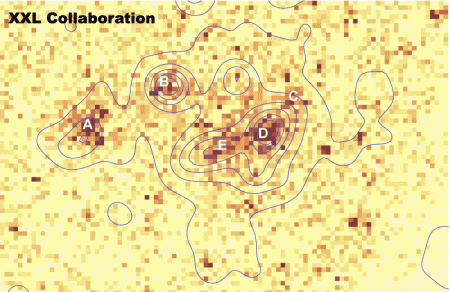A new 3D map of galaxy clusters has just been published by a research team led by Maguerite Pierre from the Astrophysics Department-AIM Laboratory of CEA-IRFU through a survey of two regions of the sky, each covering about 25 square degrees (about 100 times the area of the full moon). The survey, called XXL, was conducted from 2011 to 2013 resulting from 543 observations of the X-ray satellite XMM-Newton and requiring over 6 million seconds exposure. The XXL survey helped to locate and identify 450 clusters of galaxies and 22 000 active galaxies. Galaxy clusters are the largest structures in the Universe, reaching masses of over a hundred thousand billion times the Sun's mass. Their number and distribution were studied up to distances of about 7 billion light-years when the universe was half its present age. The XXL survey found a significantly lower cluster density than predicted by cosmological models and a quantity of gas in these clusters also lower than expected. It also allowed the discovery of five new super-cluster or clusters of clusters of galaxies. These preliminary results are subject to a first series of 13 articles, published in a special issue of the journal Astronomy & Astrophysics (in press).
Galaxy clusters, the key to the evolution of the Universe
Galaxy clusters are the largest structures in the universe, comprising up to hundreds of galaxies. According to the current cosmological model, they are formed from very low existing inhomogeneities in the early universe. These small density perturbations grow under the competing action of gravity and the expansion of the universe. They led to the gradual formation of a remarkable network of filaments and bubbles of matter surrounding voids. Over time, these overdensities become denser, fed by streams of material along the filaments. Galaxy clusters are the nodes of the cosmic web, located at the intersections of these filaments. They consist mainly of the hypothetical dark matter but are also huge reservoirs of hot gas that fills the space between the galaxies. The gas has a temperature of several tens of millions of degrees and mainly emits X-rays.
How clusters form and evolve is described by general relativity; it depends on a set of cosmological parameters such as average density of the universe, the size of the initial density fluctuations, the nature of dark matter and dark energy that is also responsible for the accelerating expansion. The goal of the XXL program is to constitute a catalog of hundreds of clusters of galaxies at distances when the universe was about half its present age to reconstruct their evolution and spatial distribution and test in this way different cosmological scenarios.
The largest satellite program XMM-Newton
Galaxy clusters are visible in X-rays through the hot gas they contain. At these energies, outside the plane of our galaxy, the brightest sources are either galaxy clusters (extended sources) or the nuclei of very active galaxies (point sources - about 50 times more abundant than clusters).
The XXL project achieved more than 500 separate observations with the XMM-Newton satellite to cover two opposite regions of 25 square degrees each. This is the largest XMM-Newton program ever allocated since the launch in 1999. 450 galaxy clusters and 22 000 active nuclei were well located and measured. To determine their distance and their properties, the XXL project was associated with a large observing program made at the European Southern Observatory (ESO) using EFOSC2 (NTT) et FORS2 (VLT) instruments and the radio wave observations made with the radio telescopes GMRT (Giant Metrewave Radio Telescope), VLA (Very Large array) and ATCA (Australia Telescope Compact Array).

The XXL Sky Survey Region in the south (S-XXL) explored by the XMM-Newton satellite. Covering an area of 25 deg2, this area was obtained through 220 different satellite observations (with a field of view is about 0.5 degrees - equivalent to the diameter of the full moon). One hundred of galaxies were detected (red circles) as well as more than 12 000 nuclei of active galaxies (AGN) visible as bright sources (white dots). Credits Projet XXL - S. Snowden, L. Faccioli, L. Pacaud
A deficit of galaxy clusters
The XXL project revealed galaxy clusters much less massive than those known so far. Very massive clusters of galaxies have indeed been recently discovered by the Planck satellite through indirect effects of the interaction of the cosmic background radiation with the hot gas of the clusters (also called the Sunyaez-Zeldovich effect). The direct measure of hot gas by the XXL project can allow to detect clusters about ten times less massive.
The full analysis performed on the 100 brightest and most massive XXL clusters notably demonstrated a property of self-similarity meaning that the brightness of the X-ray clusters does not substantially change with their distance, indicating that the distant clusters located in areas where the universe is younger appear as replicas of more local clusters.
However, the number of detected clusters is much lower than that predicted from the latest cosmological parameters determined by the Planck satellite. The difference is important because for the clusters located at distances of less than about 5 billion light years away (redshift z <0.5), the total expected number of clusters based on the current cosmological model is 115 while only 77 were observed by the XXL project. A similar difference was observed for the most massive clusters detected by Planck. This suggests either that some parameters describing the physical clusters must be revised or that the cosmological model is more complex or different from the one currently considered. The study of the full sample of 450 clusters of the XXL project, that will be published within two years, should clarify this finding.

Left: The distribution of the masses of galaxy clusters detected by the XXL project according to their distance measured by the redshift (z) [with current cosmological parameters, a redshift of z = 0.5 and 1.0 corresponds to a distance of 5 and 7.8 billion light years, respectively]. The XXL project detects clusters (black dots and squares) of mass about 10 times lower than the clusters detected indirectly by the Planck satellite (red stars) and by the telescope SPT (South Pole Telescope) (green triangles).
Right: Number of clusters detected by XXL project according to their distance. This number is consistently lower than those predicted by various cosmological models currently accepted (dotted curves). Credits Project XXL - Article II.
Supercluster: clusters in clusters
The XXL project also discovered five new super-clusters. The super clusters gather in the same part of the sky several clusters of galaxies. Our galaxy, the Milky Way is part of a local group of galaxies, itself included with several other clusters of galaxies in a large structure called the super cluster Laniakea recently discovered.
The XXL survey discovered one super clusters, called XLSSC-e, in the constellation Cetus, at a distance of about 4.5 billion light-years. This very compact super-cluster consists of six different clusters covering an area of 0.5 by 0.25 degree on the sky, which at this distance corresponds to dimensions of 10x5 million light years.
The main results of the XXL project are reported in a first series of 13 articles in the journal Astronomy & Astrophysics with the analysis of a sample of 100 clusters.
The main objective of the project is to provide an indication on the behavior of dark energy of the universe from the distribution and evolution of galaxy clusters. Galaxy clusters are the best indicators of the parameters of the universe because they are sensitive to both the geometry of the universe and to the scenarios of structure formation. The analysis of the full sample of 450 clusters discovered by the XLL project that will be published in 2017 will determine even more precisely the influence of the cosmological parameters.
The XXL project is also an important intermediate step before the next new generation of surveys that aim to cover all or a significant part of the sky such as DES (Dark Energy Survey), eROSITA (extended ROentgen Survey with an Imaging Telescope Array) , LSST (Large Synoptic Survey Telescope) and EUCLID.
The XXL survey is an international project that brings together more than 100 researchers of different nationalities, including researchers and means of CNRS, CNES, Aix Marseille University, and the Observatory of the Côte d'Azur.
Contact :
The XXL survey I : Scientific motivations, XMM observing plan - Follow-up observations and simulation programme - Pierre, Pacaud et al. 2015
The XXL survey II : The bright cluster sample - Pacaud, Clerc et al. 2015
The XXL survey III : Luminosity-Temperature Relation of the Bright Cluster Sample - Giles, Maughan et al. 2015
The XXL survey IV : Weak lensing mass – X-ray temperature scaling relation for the bright cluster sample - Lieu, Smith et al. 2015
The XXL survey V: Detection of the Sunyaev-Zel'dovich effect of the Redshift 1.9 Galaxy Cluster XLSSU J021744.1-034536 with CARMA - Mantz et al. 2015
The XXL survey VI: The 1000 brightest X-ray point-sources - Fotopoulou, Pacaud al 2015
The XXL survey VII: A supercluster of galaxies at z=0.43 - Pompei, Adami et al 2015
The XXL survey VIII : Spectroscopic MUSE and imaging CFHT view of Intra Cluster Light in a z=0.54 cluster of galaxies - Adami, Pompei et al. 2015
The XXL survey IX : 3 GHz VLA radio observations towards a supercluster at z=0.43 - Baran, Smolcic et al. 2015
The XXL survey X : Weak-lensing mass - K-band luminosity relation and implication on cluster galaxies - Ziparo, Smith et al. 2015
The XXL survey XI : ATCA 2 GHz continuum observations - Smolcic, Delhaize et al. 2015
The XXL survey XII : Optical spectroscopy of X-ray-selected clusters and evidence of AGN suppression in superclusters - Koulouridis, Poggianti et al. 2015
The XXL survey XIII: The baryon content of the bright cluster sample - Eckert, Ettori et al. 2015
The XXL survey XIV: AAOmega redshifts for the southern XXL field - Lidman, Ardila et al. 2015
Articles published in Astronomy & Astrophysics (in press).
See : the CEA-CNRS press release (15 Decembre 2015)
: the European Space Agency press release (ESA-ESTEC) (15 décembre 2015)
: the European Southern Observatory (ESO) press release (15 DEcembre 2015)
: the Astronomy & Astrophysics press release (15 Decembre 2015)
See also - "L'univers en XXL" (3 mai 2011)
- "Le plus grand catalogue de sources de rayons X de l’Univers" (7 septembre 2007)
- "L'Univers profond sondé par le satellite XMM-Newton" (16 juillet 2003)
and - the XXL website
See : Communication du Service d'Astrophysique
Redaction: M. Pierre, J.M. Bonnet-Bidaud
• Structure and evolution of the Universe
• Department of Astrophysics (DAp) // UMR AIM
• Cosmology and Galaxy Evolution
• XMM-Newton • XMM-Newton • XXL PROJECT



